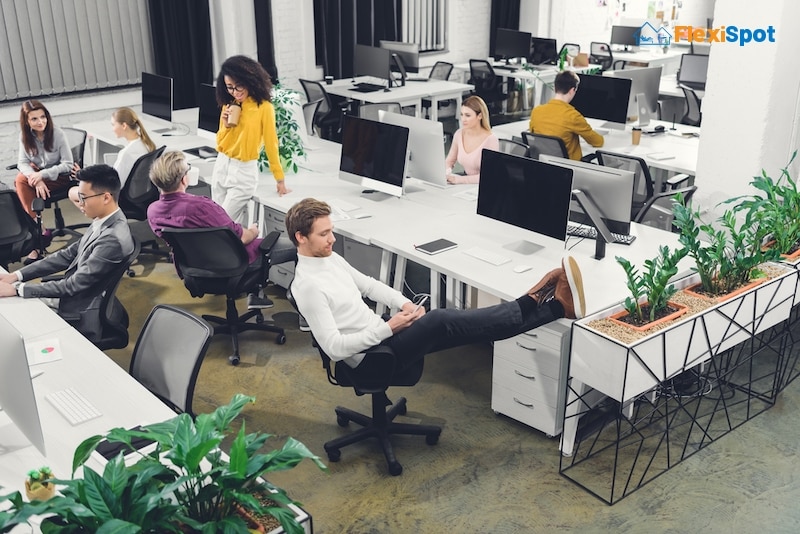While an open office setup might seem cheaper, it is not cost-effective for your company in the long run. Keep reading to find out why open office designs should be avoided when setting up your office.
In the modern work environment, an open office plan is the major go-to design for a large percentage of office settings. The few workspaces that do not adopt a completely open office design often have a combination of open offices and enclosed spaces. Open office for junior staff and midlevel managers and enclose spaces for senior management staff.
If you’ve been working for a while, you must have worked in an open office or at least been in a workspace with one at some point. To ensure we’re on the same page as we go on, let’s relearn what an open office is.
What is An Open Office?
Just as the name implies, an open office plan is an office design where all employees work in the same open space. Employees have their spaces demarcated by furniture to create a minimal sense of privacy. In some open office plans, everyone works in the open office with some reserved spots for managers. While in other designs the open office floor is for junior staff while senior management staff works in private cubicles.
There are several reasons why employers seem to prefer an open office design. While each organization has its specific reasons for adopting an open office design, there are two underlying reasons common to all. It’s the ultimate design for designing an office with limited funds and limited space. It also helps employers keep an eye on employees.
Open office designs are believed to be more cost-effective than designing individual office units for employees. It is also believed to foster interaction and creative collaboration between employees as they’re all in the same space. But is this really the case in Reality? Hardly.
Studies over time have proven that open office design does not foster collaboration as expected and is not cost-effective in the long term. In reality, an open office setup will cost your company more in the long run. You’ll find out how as you keep reading.
On the surface, an open design looks cost-effective and ideal for creating a more collaborative and engaging workspace. It often does not fulfill these objectives in reality. Some studies have shown that open offices are counter-productive in some studies. Here are some of the main reasons an open office plan should be avoided when setting up your office.
1. They do not Promote Teamwork
Contrary to popular employer opinion, open offices do not promote teamwork and collaboration as expected. Collaboration goes beyond working in the same space. You can put people together in one place but you can’t force them to work together.
Instead of promoting collaboration, open offices create tension between employees. Employees are forced to work in the same space with colleagues of different temperaments and work habits. They have to endure the bad habits of colleagues they find irritating and this ultimately creates tension. These habits would have been hidden behind closed doors if everyone had their personal office space.
And of course, you can’t collaborate effectively with a colleague you find irritating. You might even begin to resent such a person.
Another reason why people do not collaborate effectively in an open workspace is that everyone is wearing a headphone. Now, you might think banning headphones during work hours might be a solution to this, but it’s not.
People wear headphones to cancel out noise and distractions which are quite synonyms with open offices. Without headphones, some people might never be able to focus on work. Headphones mean more concentration and more work done while no headphones mean more distractions and less work done. In the former collaboration is compromised and in the latter productivity is compromised. Either way, the company loses in the long run.
2. Hampers relationship between Workers and Employers and Reduces Productivity
Although they rarely admit it, one of the reasons employers adopt open office designs is so that they can monitor their employees. They’re able to see how often employees use their cell phones and how much time they spend working. Employees are aware of this surveillance even when employers try to be discreet about it.
This constant surveillance makes employees feel like they’re being micromanaged. It creates tension between employers and employees. It puts them under undue pressure to impress and is one of the causes of workplace stress. Those that can’t keep up end up resenting their employers.
To avoid the tension and stress caused by the extra surveillance, some employees develop a way to beat the system. They appear to work all day while in reality, they’re not doing much. Combined with the noise and distractions that abound in open offices, productivity takes a hit. And the less productive employees are the less output the company makes and the less revenue it generates.
At the end of the day, the office plan that was designed to save costs becomes an impediment to productivity for the organization. And the resulting revenue losses make it counter-productive and cost-intensive.
3. Fosters Noise Pollution and Unnecessary Distractions
One of the biggest disadvantages of an open office design is the ever-present noise and distractions. Workers find it more difficult to concentrate on work in an open office than in an individual office. Try as you may, noise and distractions cannot be eliminated in an open office.
There’ll always be someone walking to the dispenser or the restroom. There’s that person that will always pull out his chair roughly and the ensuing screeching sound. How about that loud-talking colleague that forces everyone to be a part of his conversation whether on the phone or with someone in the office because he can’t speak softly?
The list of distractions goes on and on. The clicks of multiple keyboards, chit-chats among colleagues, heals tapping on the floor, multiple phone calls in the background and many more constitute noise pollution. It then falls on an employee to find a way to block out the noise if they’re going to meet their targets and deadlines. This is why most people in open offices use headphones most of the time.
4. Promotes the Spread of Illnesses
Open offices can be quite unhealthy. It promotes the spread of illnesses amongst staff. The COVID-19 pandemic highlighted this disadvantage of an open office design. One case of flu can become an office flu epidemic in a matter of days. Worst still, one case of COVID-19 in an office can result in multiple cases in hours or days especially when undetected.
And it doesn’t stop there. Employees don’t live in the office, they have to go back home after work. They interact with infected colleagues at work and then come home to their families effectively spreading the disease to their loved ones. Their loved ones will in turn interact with other members of their social community and the disease continues to spread.
Because germs spread easily in open offices, you will have to invest heavily in sanitizers. This is just to manage the situation as it’s not a permanent solution.
5. Pigeonholes Workers
People are different and so are their work preferences. Not everyone can work in a noisy environment. While some people thrive in collaborative workspaces like an open office, others do not do so well in such spaces. They concentrate more in a quiet and private setting and prefer to do their thinking and creative exercises in private before sharing their ideas with a larger group. For these people, the movement and chitchat of their employees feel like an intrusion into their privacy and hampers their productivity.
Proponents of an open office plan do not consider the individual preferences of employees. They force everybody to work in the same space irrespective of how they feel about it and how it affects their mental health. This affects the productivity levels of introverted employees causing them to underperform.
An ideal work environment should be a mix of private and collaborative workspaces. Workers should be able to determine when they want to work in private and when they’re ready for interactions. This will ensure that everyone works at optimal productivity levels. And whilst setting up separate offices can be expensive, simply creating tall partitions can do the job. Partitioning the office into small cubicles (even if not floor to ceiling) creates a certain sense of privacy.
6. Poor Ambience
Cramming too many people into the same space will inevitably generate unpleasant smells and odors. Everyone comes to the office wearing their best deodorants and body sprays so every day you have a cacophony of smells in the office. And of course, there’ll always be that colleague that wears too much perfume. It gets worse if the office space is not sufficiently ventilated. The mix of perfume and sweat in the afternoon can be a real assault on the nostrils.
But that’s not even all. You’ll have to cope with your colleagues microwaving food that smells unpleasant to you. And what happens when in an unexpected bowel movement, someone lets out a fart? It does get stuffy and smelly in an open office many times. It is enough reason to avoid this office design.
Conclusion
Workspaces have evolved, but the open office design has persisted even though there are many disadvantages to it. Most times employers opt for an open office plan because of a lack of funds and limited office space. What they fail to realize is that although they might save costs in the meantime, the costs will still be incurred in the long run by way of reduced productivity and revenue losses.
The solution to this problem is designing a hybrid office plan. The mix of open and closed workspaces makes the office more conducive to different personality types. It has also been shown to boost more productivity than open offices.
In planning your office design, do not forget to go for ergonomic office furniture. These are necessary for promoting a healthy work environment. You can shop for all types of ergonomic office furniture and accessories in the FlexiSpot store. Mind-blowing discounts are available for employee purchase programs and bulk orders.





